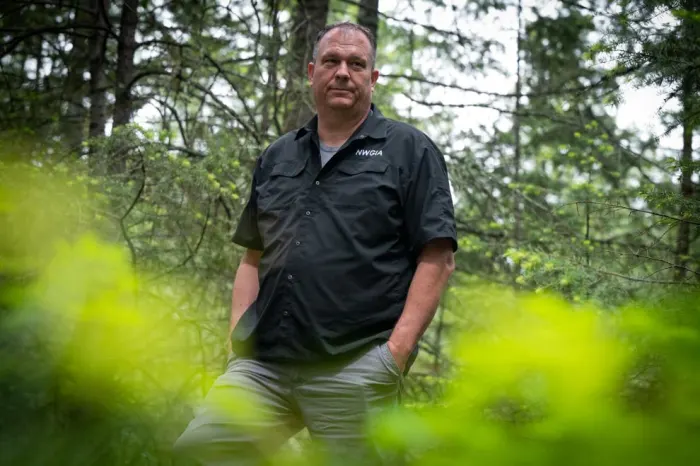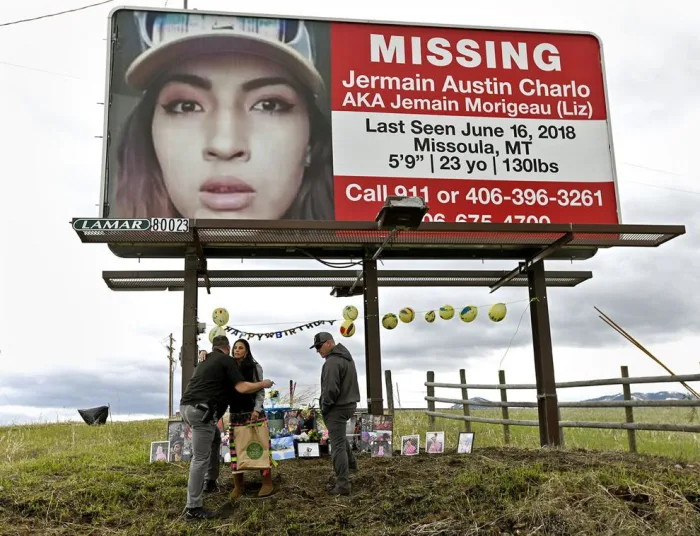Inspired by her grandparents, Tonah Fishinghawk-Chavez proves that caring for the community is an action, not just a word
Montana missing person case hits five-year mark
Jermain Charlo has been missing for a half decade. Police have made no progress in the case
Zoë Buchli
Missoulian

Missing sign for Jermain Austin Charlo. (Connie Walker via Twitter)
Friday marks five years since Jermain Charlo, a young Indigenous woman, disappeared from downtown Missoula.
“She’s not just another person who’s gone missing,” Jermain’s aunt, Valenda Morigeau, said in an interview this week. “She was a big piece in our family.”
Jermain was last seen in the early morning hours of June 16, 2018, and in the half-a-decade since, there haven’t been many developments in her case. No arrests have been made and her body’s whereabouts remain unknown. Security camera footage from the Missoula Housing Authority last showed Jermain near the Badlander, a downtown Missoula bar, at about 1 a.m. June 16. She hasn’t been seen or heard from since.

“Here we are five years later, no closer to finding her than we were at the beginning,” Morigeau said.
Most searches for Jermain have been on the Flathead Indian Reservation. Missoula Police Detective Guy Baker, the lead detective on the case, said he doesn’t think she’s in Missoula.
“When I got this case in June of 2018 I never fathomed it would not be solved five years later,” Baker said in an interview last week. “Most homicides are solved rather quickly within days or weeks and most homicides I’ve worked have been solved in conviction. So this one’s unique in that regard.”

The disproportionately high rates of missing and murdered Indigenous people is a nationwide crisis, and experts say Montana is an epicenter. While Native Americans account for 6.7 percent of Montana’s population, they account for, on average, 26 percent of the state’s active missing persons cases. A 2016 National Institute of Justice report found that more than four in five Native men and women have experienced violence in their lifetime.
Jermain’s case is still active, and Baker still works leads as they trickle in.
“We’ve identified numerous suspects, some of whom have been ruled out and are no longer suspects and others who remain suspects,” he said. “But we’ve never identified any of the suspects in the disappearance of Jermain Charlo.”
Baker said he has three theories related to Jermain’s disappearance that he’s investigated. One is the possibility that Jermain was sex trafficked; another relates to drug activity; and the third involves someone she previously had a relationship with. Baker maintains a level of ambiguity when talking about Jermain, but repeatedly mentioned missing “puzzle pieces” when he talked about solving her disappearance in an interview this week.
“I’m still hopeful that someone will come forward with the information that will be what we need to get this case to a prosecutor,” he said. “As it stands, I feel like I have most of the puzzle pieces on the table, but not all of them.”
Finding Jermain’s body would bolster the investigation, but it’s not the only thing Baker needs. No-body murder cases sometimes lead to prosecution, and Baker even called in a nationally recognized no-body homicide expert to assist with Jermain’s case. But not having remains poses obstacles for a prosecutor, he said.
Although not much information has emerged in Jermain’s case over the last five years, her relationship with her ex-boyfriend, Michael DeFrance, was brought to the public eye at a trial in April. DeFrance was convicted of four federal charges stemming from accusations that he illegally possessed firearms.
Evidence in the trial largely dealt with Jermain and DeFrance’s relationship in its early stages. The two started dating in the early 2010s. A misdemeanor assault charge was filed in Sanders County against DeFrance stemming from a domestic violence incident between the two in 2013, something that effectively barred him from owning guns.
Photos and evidence shown at the trial depicted evidence seized during a search warrant served by Baker at DeFrance’s Evaro Hill house shortly after Jermain went missing. Law enforcement found three guns on-site.
On a rainy day last week, Baker drove to Evaro Hill to a heavily wooded stretch of land about a 20-minute drive northwest of Missoula.
It’s an area he’s familiar with, as it’s been the site of several searches for Jermain. Baker turned onto Whispering Pines Road, which leads to more rural roads lined with dense forest. Not too far off the roadway animal bones were scattered on the ground.
Baker was vague about why Evaro Hill is significant in Jermain’s case.
“Evaro Hill is one area that the investigation has led us to look for Jermain for a couple different investigative reasons,” he said, but didn’t provide additional details.
Jermain’s loved ones sat through DeFrance’s two-day trial in April. Morigeau said his firearms conviction is a sliver of justice, but she’s frustrated he’s out of custody while he awaits sentencing, which is scheduled for Sept. 21. After DeFrance was arraigned on the firearms indictments, Jermain’s family said they wish the charges DeFrance was brought in on were in stronger connection to the whereabouts of their niece.
Through five years of minimal answers, Jermain’s two sons are what gives Morigeau a shred of hope. Morigeau’s family hasn’t had any contact with her boys, who are living with their father, except a single chance encounter at a local grocery store years ago.
“They’re what drives me to continue looking and never stop,” Morigeau said. Jermain’s boys have been absent from family celebrations, gatherings and holidays.
“We’ve been robbed of that for the last five years,” Morigeau said.
This article was originally published in the Missoulian.
External
This article was produced for ProPublica’s Local Reporting Network in partnership with Honolulu Civil Beat
ProPublica
Police and family looking for Angel Mendez and Zayne LaFountain
We paused some services to investigate and restore systems and we’re grateful for your patience
Through self-determination and support, Native actress rebounds from ICE confrontation
Elaine Miles remembers her friend’s sage advice on being a Hollywood professional






